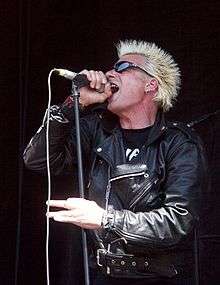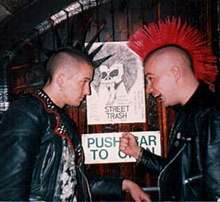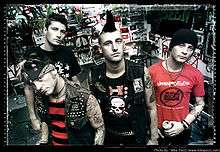Street punk
Street punk (sometimes alternatively spelled streetpunk) is an urban working class[1]-based subgenre of hardcore punk, partly as a rebellion against the perceived artistic pretensions of the first wave of British punk.[2] Street punk emerged from the style of early Oi! bands such as Sham 69 and Cockney Rejects, and the Oi! bands that followed them such as Blitz, The Business and Angelic Upstarts. A key band in defining the aesthetic was The Exploited.[3][4][5] However, street punk continued beyond the confines of the original Oi! form with bands such as GBH, Chaos UK, Discharge, The Anti-Nowhere League and Oxymoron. Street punks generally have a much more ostentatious and flamboyant appearance than the working class or skinhead image cultivated by many Oi! groups.[6] Street punks commonly sported multi-coloured hair, mohawks, tattoos, heavily studded vests and leather jackets, and clothing, especially plaids, adorned with political slogans, patches, and/or the names of punk bands.
| Street punk | |
|---|---|
| Stylistic origins | |
| Cultural origins | Early 1980s, United Kingdom |
| Typical instruments |
|
| Derivative forms | D-beat |
| Other topics | |
| Anarcho-punk | |
In the 1990s and 2000s, a street punk revival began with emerging street punk bands such as The Casualties, The Virus, Cheap Sex, Lower Class Brats and The Unseen. The Casualties achieved underground success in the 2000s.
Characteristics

Street punk music is characterized by single-note guitar lines and short solos. Unlike similar genres, such as traditional hardcore punk, street punk bands sometimes consisted of two guitarists, one of which plays guitar melodies while not singing. Street punk also makes frequent use of communal vocals, gang vocals, and sing–along choruses. Street punk lyrics commonly address topics including fighting, drinking, partying, inner-city turmoil or personal relationships. Street punk bands sometimes express political viewpoints, typically of a left-wing variety, although some street punks eschew politics altogether in favor of a more hedonistic, nihilistic outlook.
Punk veteran Felix Havoc said:
It was aggressive, yet had melody. As opposed to today's "melodic" punk it still had a lot of energy. It was honest. Hence the term "street punk." There is and was a feel that this was the kids music, from the streets, and was uncorrupted by "professionalism" or "musicianship." As opposed to the anarcho bands its message was more bleak and irreverent. The music was not a-political, just a less intellectual expression of political views of working class youth. The music was marketed as being of and by the working class. I suspect this was not universally the case. Still most middle and upper class kids cringe at frank discussions of violence as evidenced in a typical Blitz song. Early 80's UK punk was catchy as hell; it has sing-a-long choruses and hooky riffs.[4]
History
Origins (1980s)
UK 82

UK 82 (also known as UK hardcore, second wave punk[7] or No Future punk[8]) took the existing punk sound and added faster drumbeats and an aggressive distorted guitar sound.[9] The term UK 82 is taken from the title of a song by The Exploited.[10] Cross-pollination existed between this era of British street punk and American hardcore punk.[11]
The lyrics of UK 82 bands tended to be much darker and more violent than the lyrics of earlier punk bands. They tended to focus on the possibilities of a nuclear holocaust, and other apocalyptic themes, partially due to the military tension of the Cold War atmosphere. The other mainstay of the lyrics of the era was unemployment, and the policies of the Conservative Party government. Lyrics frequently denounced the Conservative leader Margaret Thatcher[12] in the same way that American hardcore punk bands addressed the Ronald Reagan administration.
The three most prominent UK82 bands, according to Ian Glasper, are The Exploited, Discharge,[13] and Charged GBH.[14] The Exploited were controversial due to their aggressive lyrics and rowdy concerts, and were considered by Glasper to be "cartoon punks".[15] Glasper wrote: "For many, The Exploited were the quintessential second wave punk band with their senses-searing high-speed outbursts against the system, and wild-eyed frontman Walter 'Wattie' Buchan's archetypal orange mohican."[15] Discharge's early work proved to be enormously influential, providing the blueprint for an entire subgenre. Their later work, however, has been described as moving into heavy metal.[16]
D-beat
D-beat (also known as Discore[17] or käng (boot), in Sweden[18]) was developed in the early 1980s by imitators of the band Discharge, for whom the genre is named.[19] The first such group was The Varukers.[17] The vocal content of D-beat tends towards shouted slogans. The style is distinct from its predecessors by its minimal lyrical content and greater proximity to heavy metal. It is closely associated with crust punk, which is a heavier, more complex variation.[18] D-beat bands typically have anti-war, anarchist messages and closely follow the bleak nuclear war imagery of 1980s anarcho-punk bands. The style was particularly popular in Sweden, and was developed there by groups such as Anti Cimex[20] and Mob 47.[21]

Revival (1990s and 2000s)
In the 1990s, a new era of street punk began with emerging street punk bands like The Casualties, Rancid[22] Cheap Sex, The Unseen, The Virus, A Global Threat, Clit 45, Career Soldiers, The Krays, Defiance, and Lower Class Brats. Many of these bands were signed by Punk Core Records.
The Casualties became one of the most well-known street punk bands and achieved underground success. Their 2004 album On the Front Line peaked at number 8 on the Independent Albums chart.[23] On the Front Line and The Casualties' 2006 album Under Attack peaked at numbers 7 and 9 on the Heatseekers Albums chart, respectively.[24]
See also
- Clockwork Orange Punks
- List of street punk bands
- Oi!
References
- Glasper 2004, p. 10
- Glasper 2004, p. 9
- Glasper 2004, p. 122
- von Havoc, Felix. "Maximum Rock'n'Roll #189". Havoc. Archived from the original on June 21, 2004. Retrieved September 9, 2008.
- Glasper 2004, p. 246
- Glasper 2004, p. 5
- Glasper 2004, pp. 8–9
- Glasper 2004, p. 384
- Glasper 2004, p. 9
- UK82 Access date: September 20, 2008.
- Glasper 2004, pp. 165, 320
- Glasper 2004, p. 203
- Matt Diehl, "The Young Crazed Peeling", My So-Called Punk: Green Day, Fall Out Boy, The Distillers, Bad Religion—How Neo-Punk Stage-Dived Into the Mainstream, New York: Macmillan, 2007, ISBN 0-312-33781-7, ISBN 978-0-312-33781-0 p. 107.
- Glasper 2004, p. 44
- Glasper 2004, p. 360
- Glasper 2004, p. 172
- Glasper 2004, p. 65: "The Varukers were the original Discore band, the first and best of the hardcore punk acts to take the simple, yet devastatingly effective formula laid down by Discharge and play it as fast, hard, heavy as they could."
- Jandreus 2008, p. 11
- Glasper 2004, p. 175: "I just wanna be remembered for coming up with that f-ckin' D-beat in the first place! And inspiring all those f-ckin' great Discore bands around the world!" – Terry "Tez" Roberts
- Jandreus 2008, pp. 20–21
- Jandreus 2008, p. 143
- DIEHL, MATT. "Agnostic Front Doc Shows a Band of Hardcore Brothers Who Never Gave Up". Rolling Stone. Retrieved 22 August 2018.
- "The Casualties Chart History (Independent Albums)". Billboard. Retrieved May 22, 2019.
- "The Casualties Chart History (Heatseekers Albums)". Billboard. Retrieved May 22, 2019.
Bibliography
- Glasper, Ian (2004). Burning Britain: The History of UK Punk 1980–1984. Cherry Red Books. ISBN 1-901447-24-3.CS1 maint: ref=harv (link)
- Glasper, Ian (2006). The Day the Country Died: A History of Anarcho Punk 1980 to 1984. Cherry Red Books. ISBN 1-901447-70-7.CS1 maint: ref=harv (link)
- Jandreus, Peter (2008). The Encyclopedia of Swedish Punk 1977–1987. Stockholm: Premium Publishing.CS1 maint: ref=harv (link)